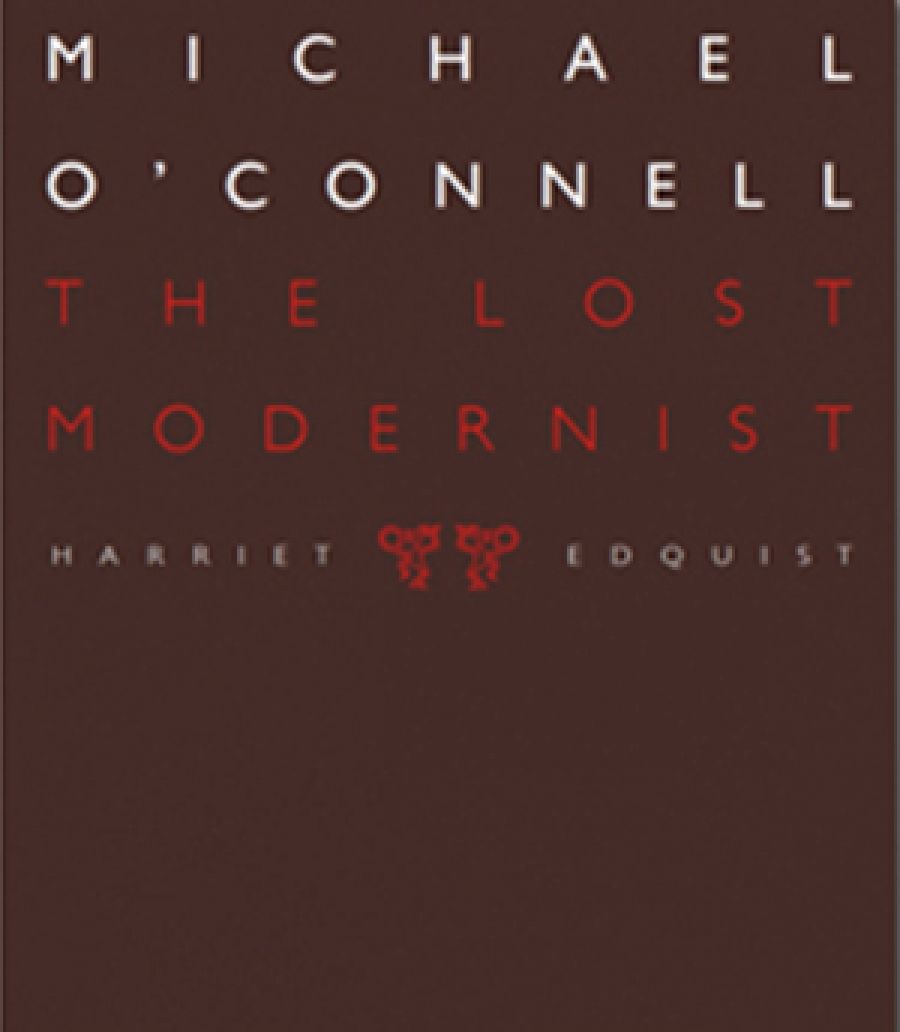
- Free Article: No
- Contents Category: Art
- Review Article: Yes
- Online Only: No
- Custom Highlight Text:
So many art books! And too many of them remainder-table compendiums of famous images thinly draped with text. It is refreshing, then, to rediscover an artist who has fallen into the slough that often follows a lifetime flush of reputation, and an art historian tenacious enough to resurrect that artist’s work and milieu.
- Book 1 Title: Michael O’Connell
- Book 1 Subtitle: The Lost Modernist
- Book 1 Biblio: Melbourne Books, $49.95 pb, 216 pp, 9781877096389
Michael O’Connell, Edquist’s ‘Lost Modernist’, was, serially, a soldier, an expatriated agricultural apprentice, a photographer, watercolourist, builder, sculptor, linocut craftsman, and celebrated textile designer. Born in Lancashire in 1898, he served on the Western Front, was captured and imprisoned. After demobilisation, he seemed destined for Cambridge, but diverted into agriculture, not happily. In 1919 his widowed mother sent him to the Antipodes, to make his way on the land. Instead, O’Connell travelled, mostly in Victoria, photographing rural workers rather than joining them.
By 1922 he had clearly decided upon a life in art, and was confidently exhibiting watercolours at Melbourne’s Athenaeum. Reviewers at the time noted his leaning towards design. Readers now will note O’Connell’s immersion in Melbourne’s Arts and Crafts community, so much more vigorous than most of us allow, and peopled by many informed and enabling women.
At the time O’Connell was camping on a block of land he had bought in coastal Beaumaris. Impoverished, he nonetheless enjoyed the artistic environs of early Australian modernism – living near Clarice Beckett, among others. When a local health inspector condemned his canvas shanty, O’Connell made a decision that helped shape his future: he hand-built a modest house out of concrete blocks that he fashioned himself. His name for the house – Barbizon – was Romantic/nostalgic, but his design principles, geared to function and born of necessity, looked to modernism. Barbizon became his personal studio. It also became a gathering place for fellow artists. And it was at Barbizon that O’Connell first experimented with the concrete garden sculpture, the linocuts, and, finally, the textiles that were to make his name.
 Michael O’Connell at Barbizon, 1932
Michael O’Connell at Barbizon, 1932
It is the alignment of craftsmanship, modernist thinking, and commitment to artistic community that clearly piques the interest of Harriet Edquist. Edquist has explored such strands before. A professor of Architectural History in the School of Architecture and Design at RMIT University, she has a knack of casting a fresh eye over buildings, movements, the interplay and implicit hierarchies of art and craft, and the shaping influence of place, in Australia and elsewhere. Among her previous publications, Pioneers of Modernism: The Arts and Crafts Movement in Australia (2008) made a finely argued and lavishly illustrated case for the distinctive way the Arts and Crafts movement manifested and indigenised, in Australia.
The Lost Modernist has related concerns but a more intense, biographical focus. At RMIT, Edquist came across some fragments of one of O’Connell’s textiles in the university’s collection, and, intrigued, conceived a research task, ‘to establish a context for the work’. The result – which surprised her as much as it will her readers – is this book, which does much more than bring back a life: it reanimates a whole period of art and craft in Australia and also in England.
O’Connell is a fascinating study. An autodidact of extraordinary enterprise, he taught himself all the skills he needed to live a complete life in art. His textile printing and production methods were complex and innovatory, and his art philosophy democratic. He was alive to the elemental and the domestic, to the place of pottery and textiles in human evolution. He built community, and understood, at first hand, the economic demands of art production. He wrote thoughtfully about his own work, about symbolism, pattern, about history, fashion, and continuities in art. He was a modernist, but also part of an antique tradition. There is a beautiful fragment of fourteenth-century Indian textile in Oxford’s Ashmolean Museum that, in its repeated blocks and graphic impact, anticipates O’Connell’s art.
So why do we not know more about Michael O’Connell? Because expatriation and war interrupted the pattern of his life – twice. On a visit back to England he was caught by the outbreak of World War II, and never returned to Australia. Fire twice destroyed his studio/homes. Barbizon burnt down in 1944, and a studio fire at his English retreat, the Chase, destroyed many of his records. Also, textile art is fragile. It gets lost. When I went looking last month for an O’Connell hanging in Oxford’s St Hilda’s College, I was told ‘we can’t find it’. Perhaps now they will.
Michael O’Connell was no William Morris, but Edquist’s engaging study prompts the right questions about why he was not, about the intersections of art and craft, about artistic production, movements, fashion, and the integrated life.
The Lost Modernist is a very beautiful book, and scholarly in the best sense. A larger typeface, serif not sans serif, and clearer page directions to connect text and illustration would be a kindness to a keen reader.
Note: In 2011 the Bendigo Art Gallery mounted an exhibition, The Lost Modernist: Michael O’Connell, to accompany this book.


Comments powered by CComment